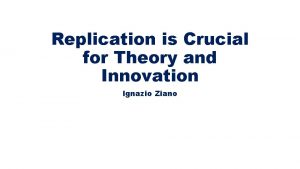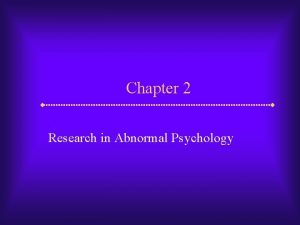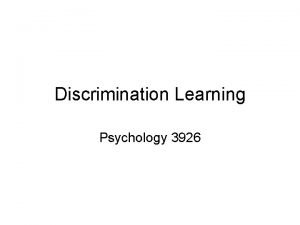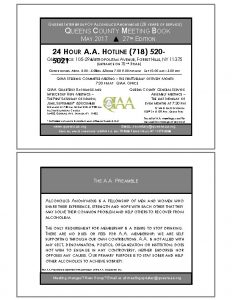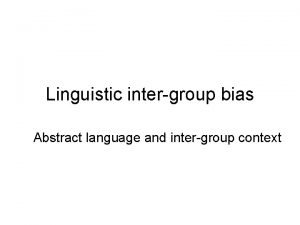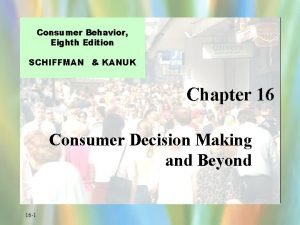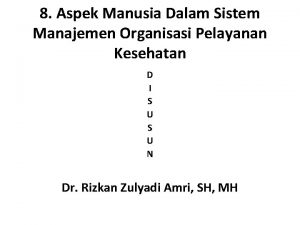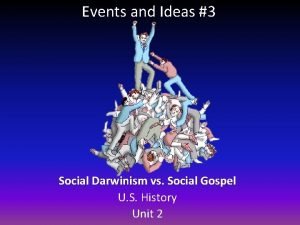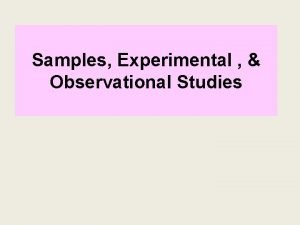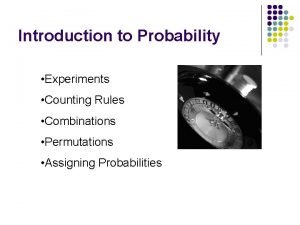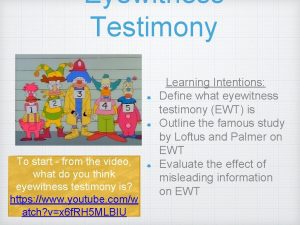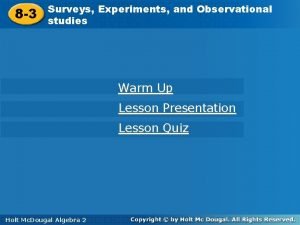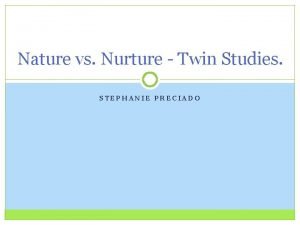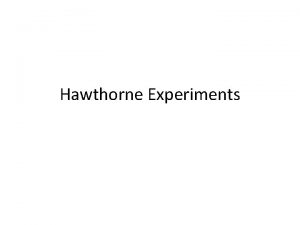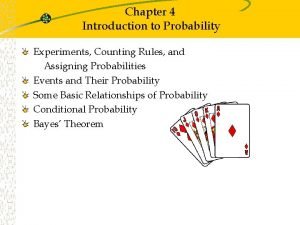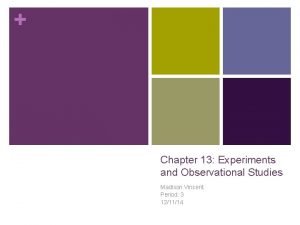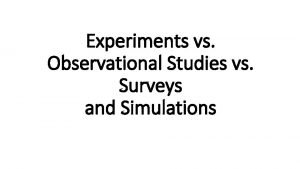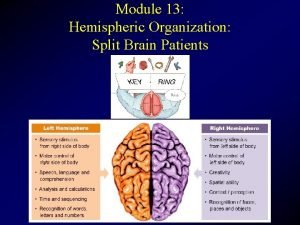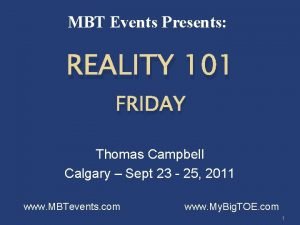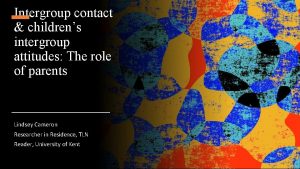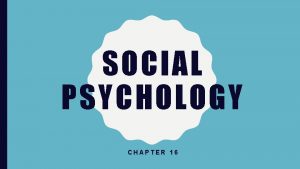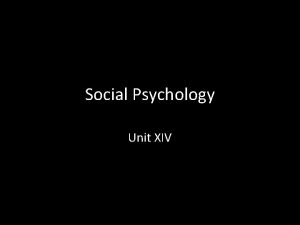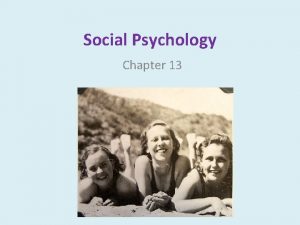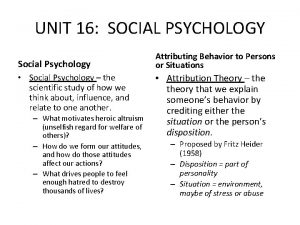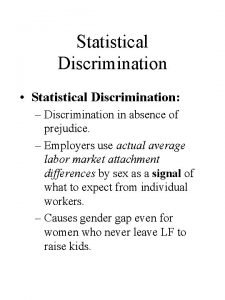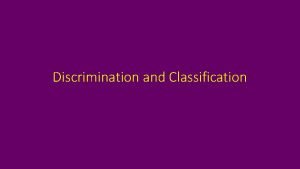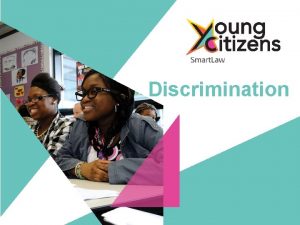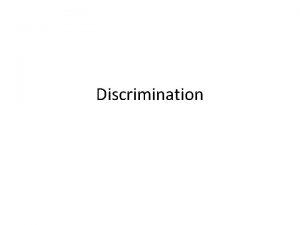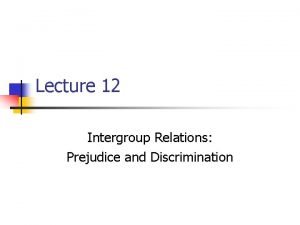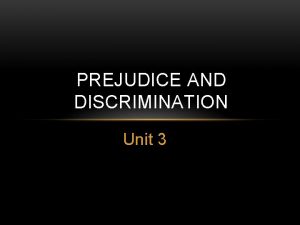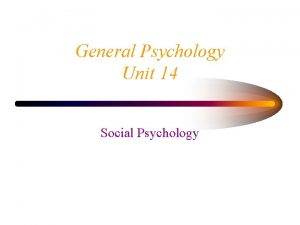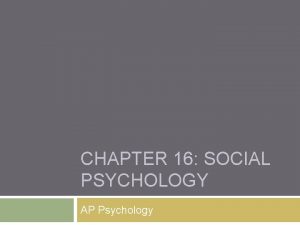Social Psychology Experiments in Intergroup Discrimination Key Study



































































- Slides: 67

Social Psychology: Experiments in Intergroup Discrimination Key Study: Tajfel (1970)

Background v Prejudice- Literally the word means to pre-judge v We have beliefs about people before we meet them v These beliefs primarily take the form of stereotypes Overall impressions based on the assumption that all members of a group possess similar attributes

Background v We all use prejudice as a mechanism by which we quickly evaluate how to interact with strangers v Discrimination is a behavior we exhibit toward people because of our prejudice

Background v Social discrimination: behavior toward or against a person or group is based on prejudged perceptions of their characteristics Behavioral manifestation of prejudice

Example v Susan Boyle v. Stereotype: Crazy cat lady: A lady never married woman with no children, who uses her wasting maternal instincts on cats v We prejudged her based on our belief she was a crazy cat lady v We discriminated against her by snickering

Background v Social Identity Theory (SIT) v SIT Tajfel & Turner in 1979 v SIT involves three central ideas: Categorization Identification Comparison

Background v Social identification: the process of gaining significant parts of our self-identity from reference to the groups to which we belong (ingroups).

Background-Categorization v We categorize objects in order to understand them v We also categorize people (including ourselves) in order to understand our social environment. We use social categories like Black, White, Australian, Christian, Muslim, student, teacher, & bus driver because they are useful

Background-Categorization v SO by assigning people to a category we (believe we) know certain things about those people v SO, we can find out things about ourselves by knowing to which categories we belong

Background-Categorization v We define appropriate behavior by referencing the norms of groups to which we belong v BUT we can only do this if we can tell who belongs to our group

Background-Identification v We identify with groups to which we perceive ourselves to belong v Identification has 2 parts: Social identity: Part of who we are is made up of our group memberships. Personal identity: Part of who we are is our perception of ourselves as individuals

Background-Identification v Sometimes it is “Us & them” v Other times it is “me & you” v Thinking of yourselves as a group member and thinking of yourself as a unique individual are both parts of your self-concept

Background v In-group-Implied by this concept of identity is the idea that we are, in some sense, the same, or identical to other people v We treat members of our ingroups as being similar to ourselves in some relevant way

Background-Identification v Out-groups are groups with which we don't identify v We treat members of the out-groups as if they were all identical & not individuals US Me You THEM

Background Social Comparison v Positive self-concept is a part of normal psychological functioning v To deal effectively with the world we need to feel good about ourselves v The idea of social comparison is that in order to evaluate ourselves we compare ourselves with similar others.

Background Social Comparison v We can gain self-esteem by comparing ourselves with others in our group (ingroup) v But this only happens IF we see ourselves as a member of a prestigious group v The question is, how do groups get this prestige?

Background v To maintain a positive self-identity we will tend to ‘put-down’ outgroups, therefore boosting our ingroups status. v This process involves the negative categorization of outgroups and negative comparison with the ingroup. This is how prejudice is created. v Discrimination will occur if we need to compete in some fashion with the outgroup.

Review v Prejudice v Discrimination v In-group v Out-group v SIT Categorization Identification Comparison

Discrimination v Sneeches

Background v Tajfel’s SIT attempts to explain: Intergroup discrimination Prejudice on the basis of group membership and self-identity

Background v Henri Tajfel , along with many other social psychologists, is interested in the psychological processes that underlie prejudice and discrimination.

Aim v To investigate the minimal conditions in which prejudice and discrimination can occur. To demonstrate that merely putting people into groups (categorization) is sufficient for people to discriminate in favor of their own group and against members of the other group.

Method/Procedure v 2 laboratory experiments v IV type of allocation they were asked to make v DV the choices they made (either being fair or showing discrimination)

The First Experiment v Sample: 64 boys who were 14 -15 years old from a comprehensive school in a suburb of Bristol. v They came to the laboratory in separate groups of eight. v All the boys in each group were from the same 'House' in the same form at the school, so that they knew each other well before the experiment.

The First Experiment v The first part of the experiment served to establish an intergroup categorization v The second part was to assess the effects of that categorization on intergroup behavior.

Procedure v In the first part the boys were brought together in a lecture room and were told that the researcher was interested in the study of visual judgments.

Procedure v Forty clusters of varying numbers of dots were flashed on a screen. v The boys were asked to estimate the number of dots in each cluster and to record each estimate.

Procedure v After the boys had completed their estimates they were told that in judgments of this kind some people consistently overestimate the number of dots and some consistently underestimate the number.

Procedure v After the judgments had been made they were “scored” by one of the experimenters. v Participants were told that researchers were interested in other decision making processes & were going to take advantage of their presence to investigate these

Procedure v Participants were told they were be grouped on the basis of the visual judgments they had just made. v Randomly assigned: half to the 'under estimators' half to the 'over estimators

Procedure v They were given the following instructions: . v The task would consist of giving others participants points which would then be converted into real money at the end of the experiment

Procedure v They would not know the identity of the individuals to whom they would be assigning these rewards & penalties since everyone would have a code number

Procedure v Each boy went to another room on their own, and was given a booklet containing 18 pages v On each page there were 14 boxes containing two numbers each

Procedure v The numbers in the top row of the matrix were the rewards and penalties to be awarded to one person and those in the bottom row were those to be awarded to another v They were not giving money to themselves

Procedure #74 12 10 8 6 4 2 0 -1 -5 -9 -13 -17 -21 -25 -21 -17 -13 -9 -5 -1 0 2 4 6 8 10 12 Over #68 Under The participant had to check one column e. g. 12 and – 25 or – 9 and 4

Procedure v At the end of the task each boy would be brought back into the first room and would receive the amount of money the other boys had awarded him

Procedure v The value of each point they were awarding was a tenth of a penny v Each row of the matrix was labeled # of over estimators # of under estimators

Procedure v The boys were required to make three types of choice. There were in-group choices, where both top and bottom row referred to members of the same group as the boy. (other than himself) There were out-group choices, with both top and bottom row referred to members of the different group from the boy. There were intergroup choices, where one row referred to the boys’ own group and one row referred to the other group.

Results v In the intergroup choices the large majority of participants gave more money to members of their own group #74 12 10 8 6 4 2 0 -1 -5 -9 -13 -17 -21 -25 -21 -17 -13 -9 -5 -1 0 2 4 6 8 10 12 Over #68 Under

Results v When the boys had an entirely ingroup (or out-group) choice to make, they tended towards the point of maximum fairness (this would be 0 and – 1 in our example). #74 12 10 8 6 4 2 0 -1 -5 -9 -13 -17 -21 -25 -21 -17 -13 -9 -5 -1 0 2 4 6 8 10 12 Over #68 Under

Conclusion v Discrimination occurred as a result of simply designating ingroup and out-group membership (categorization) v Choices were not made to maximize everyone’s winnings (joint maximum profit) but instead to maximize group profits.

The Second Experiment v Sample: 48 new boys 3 groups of 16 v Aesthetic preference: as the basis of the division into two groups v The boys were shown 12 slides of paintings: 6 by Paul Klee and 6 by Wassily Kandinsky & asked to express their preference.

Wassily Kandinsky Paul Klee The paintings were shown without any signatures so that the boys could be assigned at random to the Klee or Kandinsky group.

Procedure v After they had judged the paintings they were then told that they were being divided into groups v They were classified as the 'Klee group' or the 'Kandinsky group' named after the actual painters whose work had been shown. But really this was random

Procedure v They were told that the study was about 'decision making' v Required them to allocate points to other students v To make their allocations the participants were shown a matrix & asked to choose a pair of numbers from the same column

Procedure v Tajfel wanted to assess 3 things: 1. Maximum joint profit (MJP): a boy could give the largest reward to members of both groups 2. Maximum ingroup profit (MIP): a boy could choose the largest reward for the member of his own group regardless of the reward to the boy from the other group

Procedure v Tajfel wanted to assess 3 things: 3. Maximum difference (MD): largest possible difference in gain between a member of in-group and a member of out-group, in favor of the in-group

Procedure v Different matrices were designed Rewards # 36 of Klee group 7 8 9 10 11 12 13 14 15 16 17 18 19 Rewards for member 15 of Kandins ky group 1 3 5 7 9 11 13 15 17 19 21 23 25

You are in the Klee group v MJP =19 -25 (adding) v MIP =19 -25 (largest # for your group) v MD =7 -1 (biggest difference between the groups, favoring yours) Rewards #36 of Klee group 7 8 9 10 11 12 13 14 15 16 17 18 19 Rewards # 15 Kandinsky group 1 3 5 7 9 11 13 15 17 19 21 23 25

Results v Significant tendency to use maximum difference in favor of the in-group at the expense of maximum in-group profit even if this meant that the ingroup lost out on points

Results v MJP almost no effect at all v BUT-MIP and MD exerted a strong effect. v Participants always tried to give their in-group members the best deal at the cost of the out-group member. They always maximized the profit of their own group.

Results v In a situation where the choice was between two in-group members, participants’ choices were nearer the MJP then when the choice was between two outgroup members

Conclusions v The findings demonstrate that mere categorization into groups produces in-group favoritism and discrimination towards the outgroup

Conclusions v Out-group discrimination is easy create Previous studies have shown how conflict or earlier hostility can act as the basis for intergroup discrimination. But here neither of those had any relevance to what the participants were asked to do

Conclusion v People would rather have the outgroup suffer at the expense of ingroup loss so that social distance is created between the groups.

Evaluation-Strength v High levels of control- no confounding variables that may influence group membership (no social interaction) v So the behaviors could be explained just in terms of categorization rather than other factors (no pre-existing prejudice) v Increases validity

Evaluation-Weakness v Ecological Validity Lab setting Prejudice & discrimination are social phenomenon they are being studied in a lab Unusual task

Evaluation-Weakness v Demand Characteristics Because they were divided into groups the participants may have felt that the purpose of the study was to compete and discriminate and so acted accordingly

Evaluation-Weakness v Interpretation bias Other research suggests that the behavior of the boys can be seen in terms of fairness instead of discrimination Group membership is rarely so meaningless & is influenced by other factors

Explanation for Findings v Tajfel uses Social Identity Theory (SIT) as an explanation for intergroup discrimination. v SIT suggests that the participants favored their own group because it increases their self-esteem.

Evaluation of Explanation v SIT has become one of the main theories in social psychology. v SIT is useful because it explains the social causes of prejudice it & it may also explain individual differences ( why some people are more likely to discriminate than others)

Evaluation of Explanation v BUT in cultures that do not emphasize competition categorization does not always seem to lead to discrimination.


Vocabulary v Categorization v Demand characteristics v Discrimination v Ecological validity v In-group v Maximum difference v Maximum ingroup profit v Maximum joint profit v Out-group v Prejudice v Social identity theory v Stereotype

Review v Social Identity Theory Categorization Identification Comparison v Maximum joint profit (MJP) v Maximum in-group profit (MIP) v Maximum difference (MD)

Review v SIT-When we belong to a group, we are likely to develop our sense of identity, at least in part, from that group. We also add to our sense of identity by making comparisons with out-groups.

Sources v http: //www. holah. karoo. net/zimbardostudy. htm v Henri Tajfel (1970) Experiments in intergroup discrimination Scientific American, 223, 96 -105. v BANYARD, P. AND GRAYSON, A. (2000) Introducing Psychological Research; Seventy Studies that Shape Psychology, 2 nd Edition. London: Macmillan v GROSS, R. (1999) Key Studies in Psychology, 3 rd Edition. London: Hodder and Stoughton v HILL, G. (2001). As level psychology through diagrams. Oxford: Oxford University Press.
 Why is “replication key” psychology experiments?
Why is “replication key” psychology experiments? Abnormal psychology experiments
Abnormal psychology experiments Discrimination learning psychology
Discrimination learning psychology Intergroup dialogue training
Intergroup dialogue training Aa meetings in queens
Aa meetings in queens Linguistic intergroup bias
Linguistic intergroup bias Evoked set of brands
Evoked set of brands Intergroup vs intragroup
Intergroup vs intragroup Aspek manusia dalam organisasi
Aspek manusia dalam organisasi Umich igr
Umich igr Frustration aggression principle
Frustration aggression principle Social psychology ap psychology
Social psychology ap psychology Social psychology definition psychology
Social psychology definition psychology Group polarization vs groupthink
Group polarization vs groupthink Social thinking and social influence
Social thinking and social influence Apa itu social thinking
Apa itu social thinking Key business activities
Key business activities Contoh bisnis model canvas makanan pdf
Contoh bisnis model canvas makanan pdf Social darwinism vs social gospel answer key
Social darwinism vs social gospel answer key Social thinking social influence social relations
Social thinking social influence social relations Wonder taste
Wonder taste M&m experiments with scientific method
M&m experiments with scientific method Observational study vs experiment worksheet
Observational study vs experiment worksheet Jean piaget 1896 a 1980
Jean piaget 1896 a 1980 Counting rule for multiple-step experiment
Counting rule for multiple-step experiment A balanced outlook on law
A balanced outlook on law Science experiments for highschool
Science experiments for highschool Eyewitness testimony video experiments
Eyewitness testimony video experiments Computer science experiments
Computer science experiments Czech experiments
Czech experiments Monomer of dna
Monomer of dna Design of experiments doe
Design of experiments doe In his transformation experiments what did griffith observe
In his transformation experiments what did griffith observe Merit and demerit of standard deviation
Merit and demerit of standard deviation Doe in jmp
Doe in jmp Conducting the surveys experiments observation
Conducting the surveys experiments observation Examples of binomial experiments
Examples of binomial experiments Computer organization lab experiments
Computer organization lab experiments Francis cecil sumner, ph.d.
Francis cecil sumner, ph.d. Twins separated at birth nature vs nurture
Twins separated at birth nature vs nurture Construction portfolio examples
Construction portfolio examples Core flooding experiments
Core flooding experiments Mica splitting study
Mica splitting study Full factorial design
Full factorial design Design of experiments quality management pmp
Design of experiments quality management pmp Experiments in goodness
Experiments in goodness Spectrophotometr
Spectrophotometr Counting rule for multiple-step experiments
Counting rule for multiple-step experiments 2k factorial experiments and fractions
2k factorial experiments and fractions Chapter 13 experiments and observational studies
Chapter 13 experiments and observational studies Miller and urey's experiments attempted to demonstrate
Miller and urey's experiments attempted to demonstrate Paper presentation design
Paper presentation design Taguchi design of experiments
Taguchi design of experiments Does hot glass look the same as cold glass
Does hot glass look the same as cold glass Observational studies vs experiments
Observational studies vs experiments Pvt experiments
Pvt experiments Chattel slavery apush
Chattel slavery apush How do scientist test hypothesis? *
How do scientist test hypothesis? * Pmp stakeholder engagement plan
Pmp stakeholder engagement plan Liz sneddon experiments
Liz sneddon experiments Split brain experiments
Split brain experiments Investigating conductors lab report
Investigating conductors lab report Design of experiments
Design of experiments Viking experiments
Viking experiments Checklist for good practices in laboratory experiments
Checklist for good practices in laboratory experiments Science risk assessment primary school
Science risk assessment primary school Six sigma betekenis
Six sigma betekenis Tom campbell experiments
Tom campbell experiments
